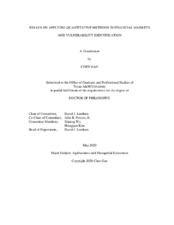| dc.description.abstract | Quantitative methods, including Econometrics, Stochastic Simulation and Classifications with Statistical Machine Learning, are widely used in financial markets and applied economics studies. In this dissertation I investigate the application of these quantitative methods to financial market study in China, risk management in U.S. Agricultural sector and food security identification in Afghanistan.
The first essay investigates the price discovery of the stock index futures (CSI 300) along with sensitivity of market structure to policy changes and the possibility of market manipulation in China by using econometrics models. Results show the cash market dominates the price discovery in general and both the long-term equilibrium and the short-term interactions between futures market and cash market are sensitive to trading policy changes. It is found that shorting the index futures does not permit manipulation of the cash market. This study finds large market reactions to regulation and the necessity of better understanding the unbalanced structure of market participants and trading policies.
The second essay investigates the survivability and probability of default of agricultural producers in the short-term future with stochastic simulation. Given the condition that USDA concludes agricultural sector level healthy while majority debts are concentrated in small proportions of producers, this study shows producers with high leverage will face significant financial stress. At moderate debt level, the financial performance of farmers are sensitive to initial liquidity and policy changes. Understanding the depth of the problem as opposed relying on national financial indicators can benefit all stakeholders in agriculture.
In the third essay, the Afghanistan National Risk and Vulnerability Assessment (NRVA) survey data is used to predict food security households in Afghanistan with machine learning methods. A food security binary indicator is first built to label vulnerable households and serve as the dependent variable. A subset of key features from the remaining variables of the dataset is then selected by the classification machine learning models to predict the indicator. We find traditional predictors, like disaster shocks and clean water access are useful predictors. The income and expenditures which all measure short-term financial situations are also important. Some variables, like dwelling wall composition and borrowing capacity which potentially serve as proxies of accumulated household wealth are also highly ranked and selected by the model. Our random forest model properly identifies 80% of the food-insecure households with Area under the Curve (AUC) of 0.851 and thus, offers an accurate way to quickly identify target households. | en |


